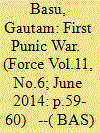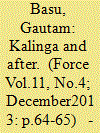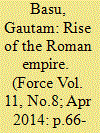|
|
|
Sort Order |
|
|
|
Items / Page
|
|
|
|
|
|
|
| Srl | Item |
| 1 |
ID:
125968


|
|
|
|
|
| Publication |
2013.
|
| Summary/Abstract |
After Issus (333 BC), Alexander took possession of Syria and the Levant coast. The next year he attacked Tyre, a rich and strategic Phoenician port and its largest city-state. Tyre was the only Persian port that had not capitulated. Even this far into the war, the Persian navy still posed a threat. Tyre was located both on the Mediterranean coast and an island with two natural harbours. Alexander built a causeway to allow his army to take the town by land. This engineering feat showed the true extent of his brilliance: he built a kilometer-long causeway on a natural land bridge no more than two metres deep. He then constructed two towers 150-feet high at the end of the causeway. The Tyrians, however, quickly counterattacked. They filled an old transport ship with wood, pitch, sulphur and other combustibles, lit it on fire creating a primitive form of napalm, and ran it up onto the causeway, which was engulfed by the flames.
|
|
|
|
|
|
|
|
|
|
|
|
|
|
|
|
| 2 |
ID:
131050


|
|
|
|
|
| Publication |
2014.
|
| Summary/Abstract |
The two leading Mediterranean powers in the post-Greek world clashed in three Punic Wars in the first of which Rome, now master of all Italy, overran Sicily, reinvented itself as a naval power and took its armies beyond Europe for the first time to Carthage in Africa
By the mid-3rd century BC, Romans had secured the whole of the Italian peninsula defeating in about 100 years every rival on mainland Italy. First the Latin League dissolved in the Latin War, then the Samnites were subjugated in three Samnite wars, and finally the cities of Magna Grecia submitted to Rome after Pyrrhus of Epirus withdrew (see FORCE May 2014). Barely decades after the last Pyrrhic War, Rome fought outside Italy for the first time. The First Punic War (264-241 BC) was the first of three fought between Carthage and the Roman Republic for supremacy in the western Mediterranean Sea. It was localised on the island of Sicily but Roman legions also landed on African soil. Carthage, located in today's Libya and Tunisia, was the world's leading naval power at that time. These wars were called 'Punic' from the Latin name for Carthaginians - 'Punici' derived from 'Phoenici' - who traced their origins to the Semitic-speaking peoples of North Africa descending from Phoenician traders of modern Lebanon and who spoke the Punic language. The Second Punic War (218-201 BC) is most remembered in military history for Hannibal's great crossing of the Alps with elephants to do what no man did before: attack Rome overland from the north. The Third Punic War (149-146 BC) involved an extended siege of Carthage, culminating in its conquest by Rome, ending the tale of one of the most illustrious military rivalries in history.
|
|
|
|
|
|
|
|
|
|
|
|
|
|
|
|
| 3 |
ID:
122628


|
|
|
| 4 |
ID:
125999


|
|
|
|
|
| Publication |
2013.
|
| Summary/Abstract |
In the episode of our chronicle of war and, civilization, we study the impact of Kalinga war on India's history and meet the military dynasties that succeeded the Mauryaas
|
|
|
|
|
|
|
|
|
|
|
|
|
|
|
|
| 5 |
ID:
137894


|
|
|
|
|
| Summary/Abstract |
Rome’s history spans 2,500 years which saw its transformation from a small village to the centre of a vast empire that witnessed the founding of Catholicism and left an indelible impact on every aspect of civilisation including, of course, military. Just as the influence of Ancient Rome’s culture, architecture, art and language on human history can never be overstated, so also the lasting impact of its episodic wars on the political map of Europe for centuries. Rome maintained the western World’s first professionally trained permanent army of career soldiers who were equipped, paid and even pensioned by the state, a far cry from the farmer-soldiers of Ancient Greece or the part-time citizen-soldiers of Athens. Ancient Rome was one of the largest and grandest military empires ever.
|
|
|
|
|
|
|
|
|
|
|
|
|
|
|
|
|
|
|
|
|